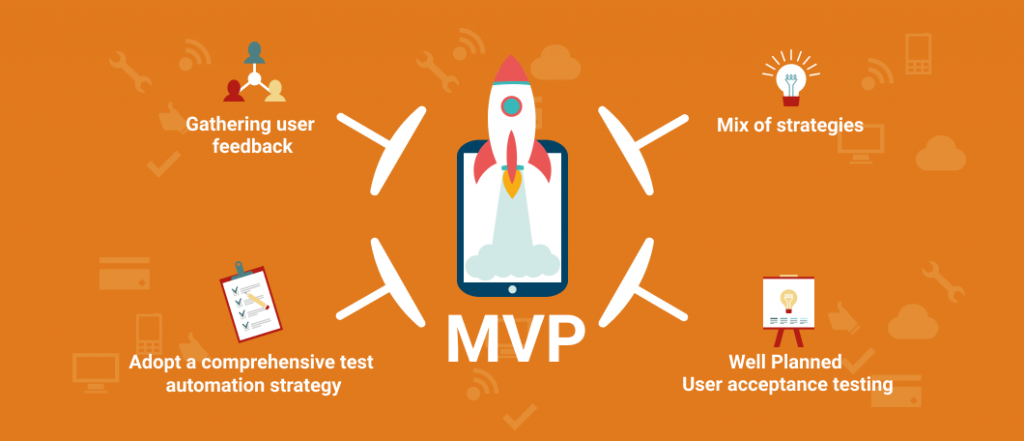Last updated on November 26th, 2022
According to Go-Globe, 74% of consumer Internet startups fail on account of premature scaling. About 29% of them actually fail even before they are fully established, whereas startups that scale normally tend to grow 20 times faster. To avoid failures and to face the scaling challenge, companies have started relying on the lean startup methodology. The methodology, propagated by Eric Ries, proposes a mix of strategies that seem to be helping startups around the world make the most of the resources they have and yet address the market opportunities meaningfully.
Arising from the Lean Startup methodology, the concept of MVP or Minimum Viable Product seems to have achieved near-universal popularity. It offers a way for startups to shorten their product release cycles and create products to satisfy the early needs of their customers. This enables them to validate the concept and market acceptance and to test the performance of the product in the initial stages itself and cut down on unnecessary risks and associated costs of development. What follows is further iterations of the MVP –each just that significant little bit better than the version that came before it.
Let’s take a closer look and understand more about the MVP concept and focus on the testing strategies involved. Read The 5 Essential Steps To Building An MVP.
What is an MVP and why does it matter to your business?
- The Minimum Viable Product gives businesses an opportunity to test the product in the market. An MVP includes only the essential features. The aim is to release fast and evaluate its validity and performance in the market. The objective is to gather feedback from early adopters of the product. This provides an edge to the companies in reducing their cost and allows them to test the product under realistic market conditions.
- The MVP is a limited version of the product which solves a set of key issues for specific users. This enables companies to test their business plan and concepts in the market early in their lifecycle. They can gather relevant user intelligence and information and can establish a foothold in the market, all while keeping efforts contained and the costs low.
- These businesses can prove the market validity of their product and build a business case for attracting more investment from VCs to further enhance product development.
- Since an MVP includes the key features and functionalities, it can help companies in building their user base. They can also understand what works well or what does not. Product teams can utilize the market feedback to make decisions regarding future iterations of the product. They can make more informed decisions about adding more relevant features and about what use-cases to add.
MVP testing and strategies for successful product deployment
- The MVP model is most favored by startups looking to get to the market fast and to optimize their costs. The customers are also different. Early adopters are thought to be more risk-taking and to that extent are willing to accept quick and dirty products that are still rough around the edges. In this scenario, the testing objectives must be defined differently. In a certain sense, the focus is on testing the core functionality of the product. To that extent, perhaps, testing all the other features may not be considered to be of as much significance.
- The MVP provides a valuable opportunity to get validation from customers about the product itself. MVP tests are not just meant to answer technical questions pertaining to the product, but also to test the basic business hypotheses and to provide important data points about the technical feasibility of the product and the effort involved and skills needed to build a successful product.
- On the one hand, there is no need for extensive testing of a product which is, by definition, incomplete, but unit testing for MVP cannot be ruled out even in such cases. This is due to the frequent iterations which will inevitably follow the code as newer and more evolved product versions emerge. Clearly, there is no room for any carried over technical debt and the resulting errors in the product functionality and usability as the changes and enhancements come about.
- Testing must be done for all the possible user scenarios in the released version. In the software context, this may include testing all the integrations and infrastructure requirements that would be needed for the product to function as designed.
- User acceptance testing is regarded to be of high importance in the MVP approach as it helps in assessing the way in which the platform interfaces with the users. This helps define if all the features and functionalities are easy to use. A well-planned UAT helps to identify bugs and other errors that may disrupt the user experience and prevent user adoption in the future versions.
- It is more difficult to build the case for automated testing in the case of the MVP approach. On the one hand, automating the testing should help faster releases, but the product could change frequently and quite significantly from version to version. To that extent, perhaps, it may prove more difficult to adopt a comprehensive test automation strategy in the MVP approach.
Conclusion
The main objective of MVP is to be able to make the most of the available market before that window of opportunity closes. Getting in early, gathering user feedback, and making insightful enhancements to the product is a smart way to get better. Adopting the right test strategies that allow for the nuances of the MVP approach will help ensure that a technically-sound MVP that provides sufficient value to the users reaches the market. That’s step one to creating a successful product that will stand the test of time!



